REVOLVER CYGNIS HIGH PERFORMANCE LOUDSPEAKER
| REVOLVER CYGNIS HIGH PERFORMANCE LOUDSPEAKER |
| In a word, remarkable |
|
|
|
Oct 2009 |
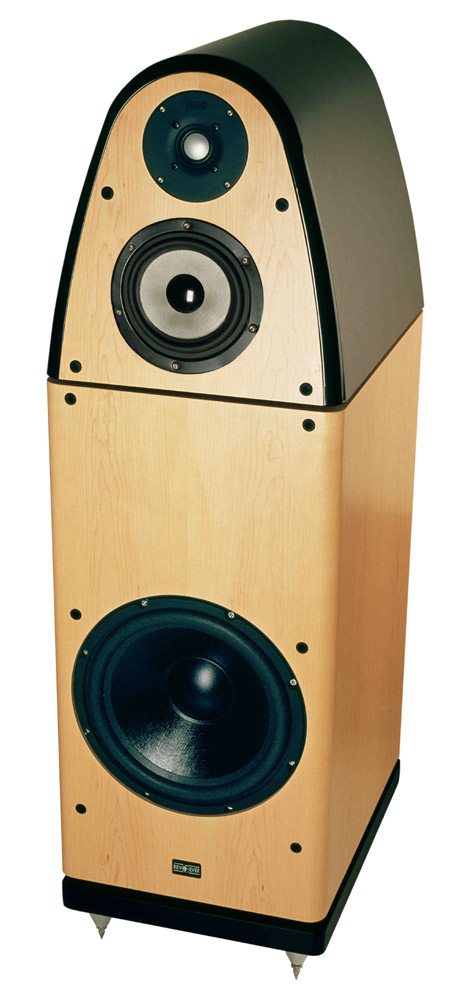
After my review of the excellent and affordable Revolver Music 3 bookshelf monitors, I was excited to learn that their top-tier offering, the Revolver Cygnis (starting at $10,500), was available for review. I had found the Music 3s so impressive and musically engaging (and very affordable at $1100), I was a little apprehensive about taking on the their bigger brothers. The Cygnis is not only a lot more expensive than the Music 3, but has a much more imposing size and appearance. Fortuitously, at around the time Clement Perry requested I take on this assignment, I was in the middle of relocating to a larger apartment with a larger living room – a perfect venue for the Cygnis.
The revitalization of Revolver as a brand name has been a long and challenging road. The company was founded by Colin and Wyn Higham back in 1979. Revolver became well-known in the United Kingdom for its affordable turntables and the company grew a speedy pace. But in 1990 Colin Higham became seriously ill and Revolver folded. Then in 2002 Mike Jewett (formally of Heybrook Hi-Fi) and Mike Greenlees (formerly of JPW loudspeakers) resurrected the Revolver name and took over running the new company.
Mike Jewitt, chief designer of the Cygnis, engineered many innovative and intricate features into the loudspeaker. For example, Jewett states that “…[enclosure resonances] greatly impact transparency and sound-staging among other things.” So the Cygnis uses a separate bass enclosure to address this potential problem. Of course internal parts and wiring are carefully chosen commensurate with a flagship offering. Not only is the Cygnis the best loudspeaker Revolver makes, it was specifically designed to prove that for a little more than $10,000 – not a staggering price as loudspeakers go – you can achieve state-of-the-art. And you won’t have to mortgage the house to do it.
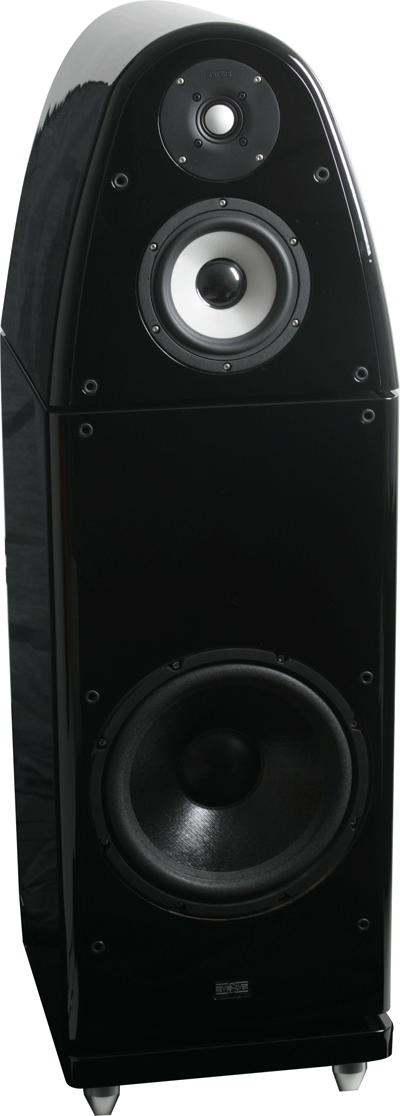 Opening the large wooden shipping crate, I was struck by how well packed the speakers were. At about 77 pounds each, the Cygnis is not extremely heavy, but unpacking these wonderfully finished, black piano gloss loudspeakers ($12,500/photo right) required some help. Once out of their crates, I followed the setup instructions faithfully. I found the owner’s manual very user-friendly. And I had to prepare my new wood floors since the Cygnis is designed with a nice-sized set of four rather large spikes. The midrange/tweeter enclosure houses a single 26mm aluminum dome tweeter and a 130mm midrange driver featuring a woven fiberglass cone, powerful double magnets, and a cast alloy frame. This sealed enclosure is constructed of molded, laminated composite material designed for optimal acoustic loading without any signature of its own. A proprietary 3-way crossover uses hand-built, air-core inductors, polypropylene capacitors, and silver plated OFC wiring. The crossover is acoustically isolated within its own enclosure.
Opening the large wooden shipping crate, I was struck by how well packed the speakers were. At about 77 pounds each, the Cygnis is not extremely heavy, but unpacking these wonderfully finished, black piano gloss loudspeakers ($12,500/photo right) required some help. Once out of their crates, I followed the setup instructions faithfully. I found the owner’s manual very user-friendly. And I had to prepare my new wood floors since the Cygnis is designed with a nice-sized set of four rather large spikes. The midrange/tweeter enclosure houses a single 26mm aluminum dome tweeter and a 130mm midrange driver featuring a woven fiberglass cone, powerful double magnets, and a cast alloy frame. This sealed enclosure is constructed of molded, laminated composite material designed for optimal acoustic loading without any signature of its own. A proprietary 3-way crossover uses hand-built, air-core inductors, polypropylene capacitors, and silver plated OFC wiring. The crossover is acoustically isolated within its own enclosure.
The bass enclosure is asymmetrically shaped to reduce standing waves. It uses a single 254mm paper-cone driver in an extensively braced, 50-liter bass-reflex design. There are two-sets of binding posts on each terminal so the Cygnis can be configured for single wire, or bi-wiring, or bi-amping. I chose to take advantage of its bi-wiring capabilities using two pairs of Acoustic Revive speaker cables.
I used the same amplifiers as I had reviewing the Music 3s: my beloved Bel Canto 1000 monos. This time however I was fortunate to get my hands on Bel Canto’s CD2 transport. Using the “shortest signal path” approach, I removed my Nuforce P9 preamplifier and relied on the CD2’s internal volume control. No regrets to date.
Space, the Final Frontier
When I first received the Cygnis loudspeakers, I was residing in a small apartment where I had the opportunity to hear them for two months. They were set up about 5′ apart, 2′ from the single side wall and about 18” from the front wall. In my new apartment they were initially set up 7′ apart, 5′ from the sidewalls and 4′ from the front wall. The sonic differences between the two locations are astonishing.
In the smaller space the overall performance was a big improvement over the Music 3s. There was an airiness to the top end that is missing in the smaller 3s. The Cygnis’ low-end was, however, powerful and weighty. As a result, room modes were readily excited, and this forced me to play at lower than usual volumes. Not good. In my new space, I am able to play at higher volumes without room resonance problems. I also notice far better bass pitch, integration and articulation, not to mention improved sound stage width and depth. Ease and flow are improved allowing the music greater dynamic contrast. Loud swings are just that, but with very little distortion and edginess. The Cygnis sounded good in my smaller place, but they really come to life in a large space.
The Cygnis possess a fuller, more robust tonal palette than the Music 3s. This tonal rightness extends from top to bottom, but I especially noticed it in regard to the smoothness of transitions between the midrange/tweeter and bass enclosures. I am not a speaker designer so I don’t know what the advantages are or the reasoning is behind separating bass enclosures. I imagine that it is not inexpensive to go this route. I know many speaker designers employ similar techniques. That said, I cannot begin to express to you the sense of marvel and absolute surprise I had when hearing the Cygnis. Especially in my new apartment.
As good as the Cygnis were in my smaller apartment, when I moved them to my new digs, things got quite interesting. Now, with the Cygnis loudspeakers spread 8 feet apart and almost 6 feet from the front wall, the sound stage has improved proportionately with no exaggeration, and no hole in the middle. I did find that toe-in was of greater importance the more I spread them apart. I ultimately settled on zero toe-in. Comparatively, when listening to the Cygnis in my smaller room, set closer to the back wall, I definitely noticed the bass was more tilted into the midband and less taut. Now I am able to appreciate the richness and even-handedness of the frequency extremes. This, of course, leads to a more effortless flow and greater musical enjoyment. Precisely what the Cygnis were designed for.
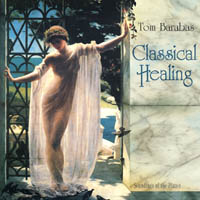 While listening to Tom Barabas’ beautifully recorded Canon In D from his “Classical Healing” CD, I was reminded why I love classical music. Granted this is more contemporary than Mozart or Wagner, nonetheless I was translated into another space and time. It’s a simple melody performed with just piano and strings, reminiscent of chamber music. With the Cygnis’ hypnotic touch, Canon In D possessed a level of purity, transparency and depth all at once. When I closed my eyes, I felt like the musicians where sitting front and center, there was an improved sound stage with respectable doses of front to back layering.
While listening to Tom Barabas’ beautifully recorded Canon In D from his “Classical Healing” CD, I was reminded why I love classical music. Granted this is more contemporary than Mozart or Wagner, nonetheless I was translated into another space and time. It’s a simple melody performed with just piano and strings, reminiscent of chamber music. With the Cygnis’ hypnotic touch, Canon In D possessed a level of purity, transparency and depth all at once. When I closed my eyes, I felt like the musicians where sitting front and center, there was an improved sound stage with respectable doses of front to back layering.
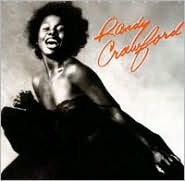 I also listened to one of my all-time favorite female vocalists, Miss Randy Crawford. Her voice has always been soothing and soulful. The song “Now We May Begin” from the CD of the same name lifted my spirits to great heights. My heart and emotions are always in the forefront when it comes to music. I therefore judge components based on how well they convey music on an emotional level, not on a visceral or dynamic one. I can listen to a one-watt system all night if it is emotionally honest and accurate. I was able to easily “get in” and reflect on Randy’s piercing vocals, while simultaneously basking in Joe Sample’s meticulous piano playing. Nobody plays it like Joe!
I also listened to one of my all-time favorite female vocalists, Miss Randy Crawford. Her voice has always been soothing and soulful. The song “Now We May Begin” from the CD of the same name lifted my spirits to great heights. My heart and emotions are always in the forefront when it comes to music. I therefore judge components based on how well they convey music on an emotional level, not on a visceral or dynamic one. I can listen to a one-watt system all night if it is emotionally honest and accurate. I was able to easily “get in” and reflect on Randy’s piercing vocals, while simultaneously basking in Joe Sample’s meticulous piano playing. Nobody plays it like Joe!
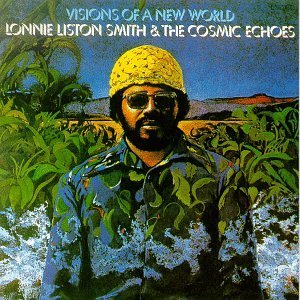 I went back and dug out jazz organist Lonnie Liston Smith. When Lonnie made the transition from sideman to leader in 1973, it was the beginning of a fusion/crossover/post-bop band he dubbed Lonnie Liston Smith & the Cosmic Echoes. It was interesting to hear how the Cygnis was able to play Lonnie’s electronic synthesizer with an unbridled sense of intensity and rightness. A rare combination indeed. Moreover, a new sense of effortlessness, preciseness and dynamic scale was evident in a way I’ve not experienced before in my home. The Cygnis’ bass reproduction was richer in scale and weight – thanks to its remarkably tight and tuneful, yet soulful, bass enclosure. This accurate bass reproduction allowed me to hear much more easily into the rest of the frequency range. With so many layers on electronic instruments, it’s been my experience that sometimes the midrange becomes over-saturated with excessive resonances, strain and compromised design goals. Luckily, the Cygnis appear to suffer from none of these issues as it soared through even some dated recordings with a sense of ease and beauty I’ve not experienced before.
I went back and dug out jazz organist Lonnie Liston Smith. When Lonnie made the transition from sideman to leader in 1973, it was the beginning of a fusion/crossover/post-bop band he dubbed Lonnie Liston Smith & the Cosmic Echoes. It was interesting to hear how the Cygnis was able to play Lonnie’s electronic synthesizer with an unbridled sense of intensity and rightness. A rare combination indeed. Moreover, a new sense of effortlessness, preciseness and dynamic scale was evident in a way I’ve not experienced before in my home. The Cygnis’ bass reproduction was richer in scale and weight – thanks to its remarkably tight and tuneful, yet soulful, bass enclosure. This accurate bass reproduction allowed me to hear much more easily into the rest of the frequency range. With so many layers on electronic instruments, it’s been my experience that sometimes the midrange becomes over-saturated with excessive resonances, strain and compromised design goals. Luckily, the Cygnis appear to suffer from none of these issues as it soared through even some dated recordings with a sense of ease and beauty I’ve not experienced before.
Lastly, I pulled out the late, great Morgana King’s “A Taste Of Honey” CD. I was floored by Morgana’s slow and styled phrasing. She’s never sounded better! The title song sounded so much more “there” and closer to what I could only describe as “the real thing.” For the first time, I could hear Morgana, ever-so slightly channeling her breaths between notes. Some of the older recording engineers really knew their stuff. This disc, from 1963, never once appeared over-saturated and/or over-done.
In a word, remarkable
The multifarious variables in putting together an excellent high-end system are challenging. Loudspeakers might just be the single most important element in the mix. And with all the loudspeakers available to a high-end enthusiast, choosing the right one can be a tough decision. The Revolver Cygnis’ sonic capabilities disarmed this listener to such a degree that I felt it is one of the “great unsung” full-range loudspeakers available. This product speaks more to the heart than the head. The Revolver Cygnis loudspeaker has become my new benchmark in the below $15,000 category. I fell so in love with its intense musicality that I was going through separation anxiety at the thought of returning them. And I ended purchasing the review pair as my new reference. Need I say more?

Clement Perry’s sonic impressions: I feel fortunate to have Carlos as a friend and can vouch for his intense love and knowledge of music. That said, his newest treasured possessions are the Revolver Cygnis loudspeakers. To be honest, I knew they’d be good because I’m now enjoying their remarkably affordable and excellent sounding Music 3s Carlos reviewed early this year (here), but I didn’t think they’d sound this good. Vivid, translucent and fast are the three words that come to mind whenever I sit before these attractively built English floorstanders.
There’s a sure-footedness about the Revolver Cygnis’ musical stance as they do shy on the rich side of neutral. They certainly do not sound flat in terms of their frequency but a tad richer in the midrange than many other loudspeakers I’ve heard. I consider this a compliment because it’s more a sensation you get later, after a listening session, rather than during one. You’re sort of left with that warm fuzzy feeling as I do when I leave a great jazz club like the Jazz Standard. Another thing, there’s nothing temperamental about the Revolver Cygnis. They’ll play loud or soft, small ensembles, rock, classical and big band with equal deft. I am responsible for dubbing the Revolver Cygnis as the “great unsung” loudspeakers available today because they’re basically unknown in the US which I think is partly criminal. Carlos did a wonderful job exacting their sonic attributes here in this review. Lets hope someone looking for a great loudspeaker will place the Revolver Cygnis on their short list after reading this. Highly Recommended!
![]()
Specifications:
FREQUENCY REPONSE: 30Hz – 30Khz +/- 6db (45Hz – 22Khz +/- 3db)
SENSITIVITY: 91db/w
NOMINAL IMPEDANCE: 8 Ohms (minimum 4.3 Ohms)
CROSSOVER: Full 3 Way acoustically isolated in dedicated enclosure.
DRIVERS: Tweeter 1” anodized aluminum dome
Midrange 5” woven fiber glass diaphragm with cast aluminum chassis and shielded double magnet.
15-litre enclosure using advanced composite material with Kapex foam core, with a high gloss black metallic finish.
Veneered baffle with colour and grain matched to bass enclosure.
Bass 10” doped compressed paper diaphragm with cast aluminium vented chassis and double magnet. Extensively braced, acoustically isolated 50-litre veneered enclosure.
Reflex loading via low noise distributed port.
(2) driver positions for accurate LF ‘in room’ performance.
AMPLIFIER POWER: 15 Watts – 300 Watts
WEIGHT (each): 77.16 lbs.
Price: $14,995
US Distributor:
May Audio Marketing, Inc.
2150 Lberty Drive
Unit 7
Niagara Falls, New York 14304
U.S.A.
T-716-283-4434
F-716-283-6264
Toll Free-800-554-4517
E-mail: mayaudio1@aol.com
Web site: www.mayaudio.com
THE ACOUSTIC PARTNERSHIP LLP
P.O.Box 341
Saltash
Cornwall PL12 6UZ
United Kingdom.
Tel: +44 (0) 87 0047 0047
Fax: +44 (0) 87 0047 0048
email: info@revolveraudio.co.uk
Website: www.revolveraudio.co.uk
US Distributor: www.usahifi.com
![]()
Don’t forget to bookmark us! (CTRL-SHFT-D)
Stereo Times Masthead
Publisher/Founder
Clement Perry
Editor
Dave Thomas
Senior Editors
Frank Alles, Mike Girardi, Russell Lichter, Terry London, Moreno Mitchell, Paul Szabady, Bill Wells, Mike Wright, and Stephen Yan,
Current Contributors
David Abramson, Tim Barrall, Dave Allison, Ron Cook, Lewis Dardick, John Hoffman, Dan Secula, Don Shaulis, Greg Simmons, Eric Teh, Greg Voth, Richard Willie, Ed Van Winkle, Rob Dockery, Richard Doran, and Daveed Turek
Site Management Clement Perry
Ad Designer: Martin Perry





Be the first to comment on: REVOLVER CYGNIS HIGH PERFORMANCE LOUDSPEAKER